- Norton ES, Beach SD, Gabrieli JD.Neurobiology of dyslexia. Curr Opin Neurobiol. 2015 Feb;30:73-8.
- Peterson RL, Pennington BF, Olson RK. Subtypes of developmental dyslexia: testing the predictions of the dual-route and connectionist frameworks. Cognition. 2013 Jan;126(1):20-38.
- Siegel LS. Perspectives on dyslexia. Paediatrics & Child Health. 2006;11(9):581-587.
- Dyslexia - Reading Disorder - (https://en.wikipedia.org/wiki/Dyslexia)
- Dyslexia - (http://www.mayoclinic.org/diseases-conditions/dyslexia/basics/definition/con-20021904)
- Understanding Dyslexia - (https://www.understood.org/en/learning-attention-issues/child-learning-disabilities/dyslexia/understanding-dyslexia)
- Dyslexia Action - (http://www.dyslexiaaction.org.uk/)
- Overview - Dyslexia - (http://www.dyslexia-international.org/wp-content/uploads/2016/04/DI-Duke-Report-final-4-29-14.pdf)
- About Dyslexia - (https://dyslexiaida.org/)
- What is dyslexia? - (http://dyslexiaassociation.org.au/how-is-dyslexia-evaluated)
- Dyslexic - (http://www.bdadyslexia.org.uk/dyslexic)
- Dyslexia Association - (http://www.bdadyslexia.org.uk/)
- Understanding Dyslexia - (http://kidshealth.org/en/parents/dyslexia.html)
- Educational Therapy for Dyslexia - (http://alphatoomega.org/india)
What is Dyslexia?
Dyslexia is a developmental reading disorder (DRD) that occurs in children with normal intelligence. It is a reading disability despite intelligence, motivation, and educational opportunities that occurs when the brain does not properly recognize and process certain symbols.
‘Dys’ means ‘difficulty’ and ‘lexia’ means ‘words’; thus ‘dyslexia’ means ‘a person who has difficulty with words’. Dyslexia is a disorder that affects millions of people all around the world. Approximately 5 -17% of the world population is diagnosed to be suffering from various degrees of dyslexia.
Dyslexia is caused due to impairment in the brain’s ability to translate images received from the eyes or ears into understandable language.
Dyslexia is a lifelong condition and so it may affect an individual differently at various stages of life. It is seen that even though a dyslexic child has great difficulty in coping with normal schoolwork, he may be interested in other aspects like sports or extracurricular activities. It is here that the child needs to be encouraged tremendously so that he/she can overcome the low self-esteem.
Awareness and help for dyslexia is still not available as commonly as it should be.
Facts and Statistics about Dyslexia
- Dyslexia is the most common learning disability affecting at least 1 in 10 children worldwide.
- This translates to 700 million children and adults who are at risk around the world.
- According to the estimate, 32 million in the United States, 6.4 million in the United Kingdom and 125 million in India will potentially have dyslexia.
- Dyslexia affects girls and boys alike.
- Dyslexia affects all ethnic or socio-economic groups alike.
- If undetected by the 2nd grade, dyslexic children grow up to be dyslexic adults at which point there is no cure and they have to learn to compensate.
- Hence, if teachers are trained in early identification and intervention of dyslexia, 90% of those affected can be educated in the mainstream classrooms and adult dyslexia can be prevented.
- Some dyslexic children with extraordinary intelligence are Albert Einstein, Alexander Graham Bell, Thomas Edison, Winston Churchill, Benjamin Franklin, Wolfgang Amadeus Mozart and John Lennon.
What are the Causes of Dyslexia?
Neuroanatomical: Dyslexia is caused due to impairment in the brain’s ability to translate images received from the eyes or ears into understandable language.
It has been proved that the brain of a dyslexic person is structurally and functionally different from that of others. Studies have shown that the inborn wiring system of the brain related to developing mental skills is different in dyslexics and this is the root cause of dyslexia.
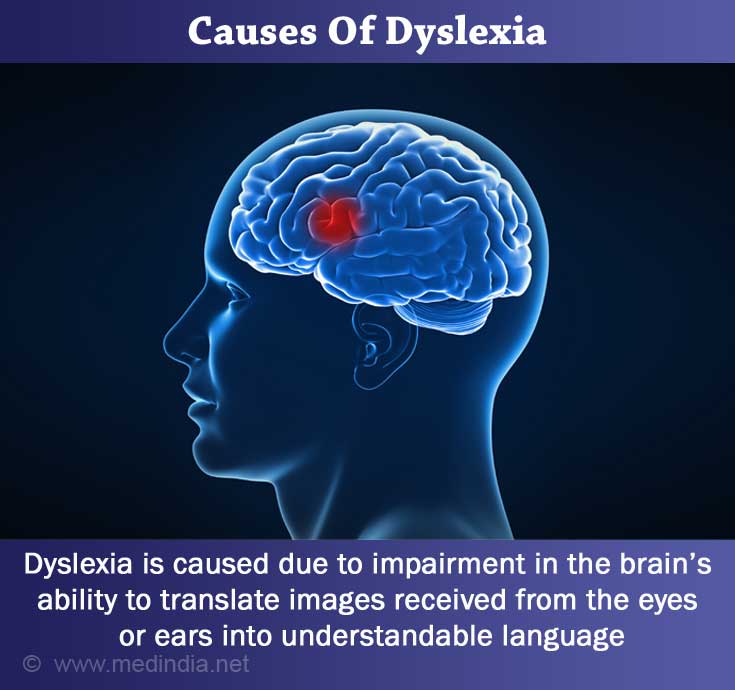
The wiring system of the brain or the neural pathway is the process that codes the information the sensory organs receive and stores it in the brain for future assimilation. This information is later used to assess situations and develop response patterns to the situations, increase the muscular co-ordinations according to the situations, or even help us in understanding and comprehending the constant inputs our brain is getting in terms of everyday activities, school procedures etc.
In a dyslexic child, even these minor acts of comprehension and usage may take a lot more time and skill than a normal child.
Genetics:Dyslexia had been linked to genetic reasons. According to research conducted by M. M. Nothen and others, the inability to learn spellings can be linked to genes on chromosomes 6 and 15.
What are the Symptoms of Dyslexia?
- Difficulty in verbal skills, abstract reasoning
- Impaired hand-eye coordination
- Poor concentration, perception, and memory
- Impaired social adjustment
These problems result in the individual obtaining poor grades and becoming classified as an under achiever. Due to this the dyslexic child is often labeled as lazy, low intellect and unmotivated. Eventually, this affects the child's personality resulting in a low self-esteem.
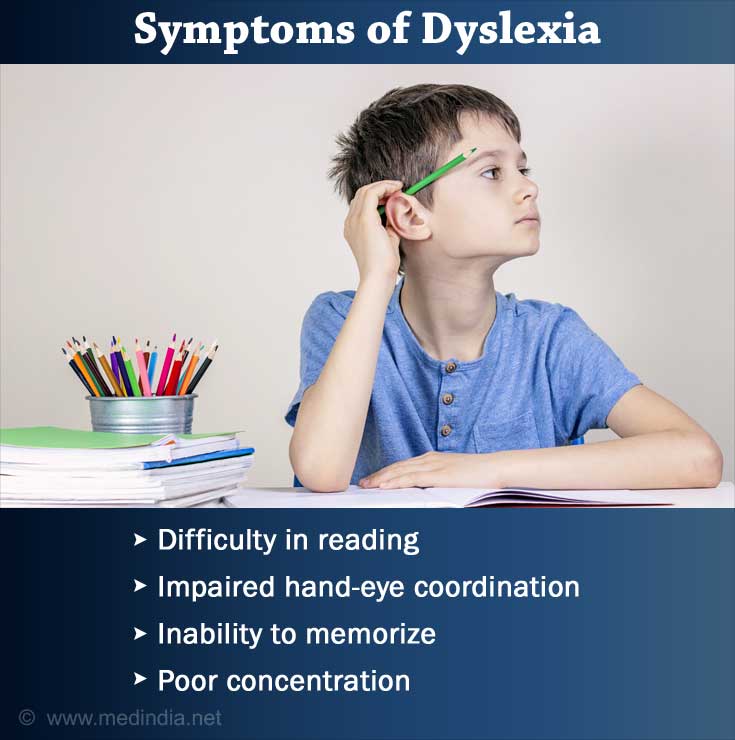
Some of the common modes of presentation of dyslexia are –
- Difficulty in comprehending
- Difficulty in expression (written or oral)
- Understanding letters phonetically or otherwise
- Difficulty in reading
- Inability to memorize
- Difficulty in spelling and reading (especially with English phonetic as it is a mixture of different languages)
- Difficulty learning any new language
Some children may initially have fewer problems in learning a language in school, but their problems may be aggravated as they learn more intricate parts of the language like grammar, or understanding of textual matter.
Associated Learning Disabilities
- Difficulty in doing simple mathematical problems (Dyscalculia)
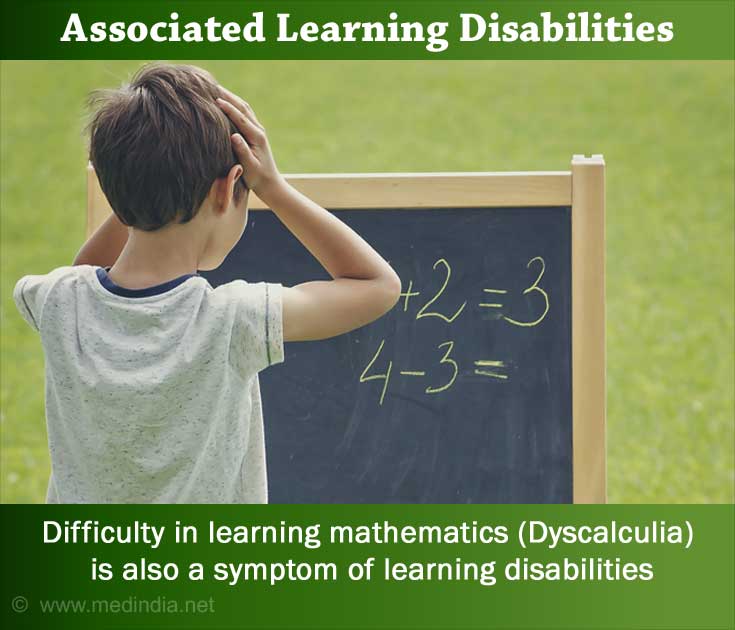
- Impaired letter handwriting and impaired spelling (Dysgraphia)
- Difficulty in attending to class instructions, and get distracted too much (Attention Deficit Hyperactivity Disorder- ADD/ADHD)
- Listening disability that causes auditory processing problems (Auditory processing disorder)
- Inability to carry out routine tasks involving fine motor skills and balance (Development coordination disorders)
How is Dyslexia Diagnosed?
Early intervention is very effective in dyslexia.
When any reading or writing disability is present (sometime between kindergarten and second grade), it is important to check for other health issues like hearing problems, vision problems and Attention Deficit Hyperactivity Disorder(ADHD) first so they can be eliminated. Teaching methods or approaches can be changed to see if they help.
If the problem persists, an in-depth assessment might become necessary. The child’s problems and all interventions tried so far have to be discussed with the teacher along with the school’s special educational counselor.
You might be asked to see a trained counselor, educational psychologist or a qualified dyslexic specialist to diagnose dyslexia. The child may be evaluated with a series of tests to confirm the diagnosis of dyslexia.

- Information about family history
- Oral language skills especially phonological processing like identifying, pronouncing, or recalling sounds.
- Academic abilities including reading (word and pseudo-word), writing, language development and vocabulary
- Ability to access and process visual and auditory information
- Reading comprehension
- Arithmetic, logical reasoning and memory
- Ability to use psychological processes of imagination, creativity, and reasoning with language
The family of the child also needs to be assessed to understand family history. It is a combination of all these details which provides the information whether the child is lagging in school because of dyslexia or any other problem.
What is the Treatment for Dyslexia?
Dyslexia is a life-long condition - so the first step in treating it is early intervention, followed by multi-sensory teaching approach and emotional support.
The earlier a dyslexic child is diagnosed, the easier it is for counselors to help them. With proper guidance, a dyslexic child can overcome his difficulties to a large extent and have a better life. This is done in a two-phased approach. The first phase is teaching the child using a multi-sensory learning procedure. The second phase is the emotional support extended by the counselor.
1. The multi-sensory approach
The key to helping a dyslexic child is through multi-sensory learning methods. Academic modules need to be broken down into smaller concepts that can be explained using multi-sensory inputs of touch, smell and sound.
As each letter is learned, children also learn to distinguish the sound of it. In a typical scenario of multi-sensory learning, the teacher may make the sound and the child may be asked to write the letter.
2. Emotional support extended by the counselor/ teacher
A dyslexic child may need the help of a counselor who will be working in tandem with the instructor in school, so that between the teacher in the classroom and the counselor at other times, the child gets the maximum help that will make him work at the same pace as his classmates.
It is important to remember here that dyslexia does not mean any disinterest to learn, but means an impediment to learning that will need some extra help. One way to help such children will be to give them extra time to finish their assignments, help them in taking down class notes etc. Often taped books and texts help them learn better, as does the use of a computer in helping them to write.
A dyslexic person will also require counseling to deal with the stress of additional work hours, and emotional problems associated with it.
3. Assistive Technologies:
There are some assistive technologies available in the markets that can help the dyslexic people in reading, writing, math and organizing.
Examples are:
- Computer software to write or read texts
- Applications on hand-held electronic devices to read texts, communicate and organize work and learning
- Specialized devices like reading pens and scanners, calculators or talking dictionaries to help with daily tasks
Livescribe Smartpen is a pen that records classroom discussions thus facilitating the child in note taking and learning.
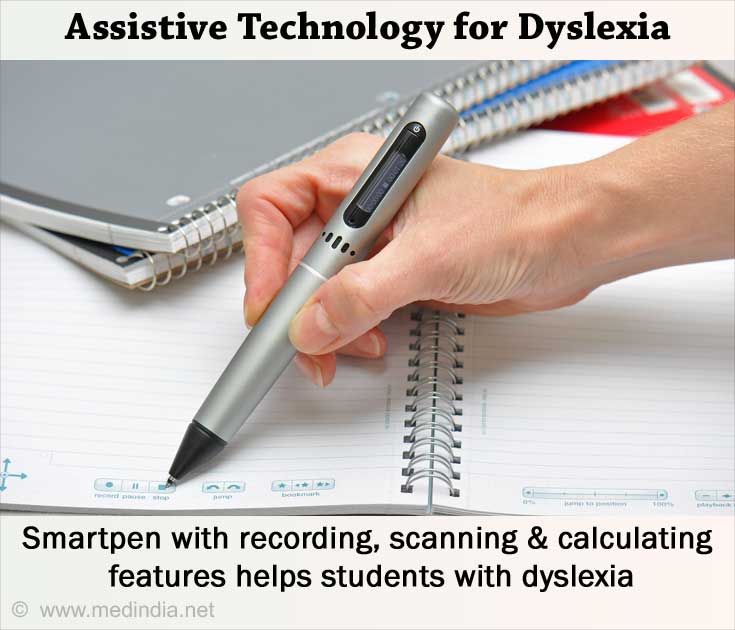
Dragon Naturally Speaking for PC users and Dragon Dictate for Mac users is a voice recognition program where you can dictate your ideas and they would be translated on the computer screen.
The 3 technology must-dos for dyslexia should be to support reading and learning, to support note-taking and to support spelling and writing.
4. Parental Support:
The parents of children diagnosed with Dyslexia can support their children in every possible way. They can help them so that the children may grow up to have a career of their own and become independent. Here are some guidelines for the parents-
- Address the problem early: Recognize your child’s difficulties as early as possible.
- Work with your child’s teacher: Work together with the teacher and counselor to understand the child’s problem and the role you can play in the child’s life. Ensure that your child gets the special treatment required for his/her special abilities. The child may be different but not unique. Help him/her to participate in normal class work and school activities.
- Teach organizing skills: Teach the child to organize his/her own room, table, work and time.
- Encourage their talents; Dyslexic kids are usually gifted in certain areas. Encourage the child to develop these hobbies.
- Encourage reading: Read aloud to your child from 6 months of age. Designate a reading time for everyone in the house so the child learns by example.
What are the Complications of Dyslexia?
1. Adjusting and anxiety issues
Persons suffering from dyslexia are often inconsistent in their performances. What they can do well today, they have difficulty in repeating it another day. Even if they are making errors in their outputs, the nature of errors may vary each time, confusing both the dyslexic persons and their guides. Hence, often a dyslexic person feels more anxious throughout the day than any other differently-abled person.
2. Social and emotional problems -
Dyslexic persons have been observed to be less socially or emotionally mature than their peers. This may cause poor self-image and fewer acceptances by peers.
A dyslexic person may react differently to social situations, because of their social immaturity, causing embarrassment to others.
Later in life when language becomes one important way of expression, a dyslexic person may feel disabled in establishing emotional bonding and social relationships.
Some other emotions most commonly experienced by dyslexic people are anger about themselves and others, depression due to inability to fit the surroundings and frustration of not being able to perform to their satisfaction.
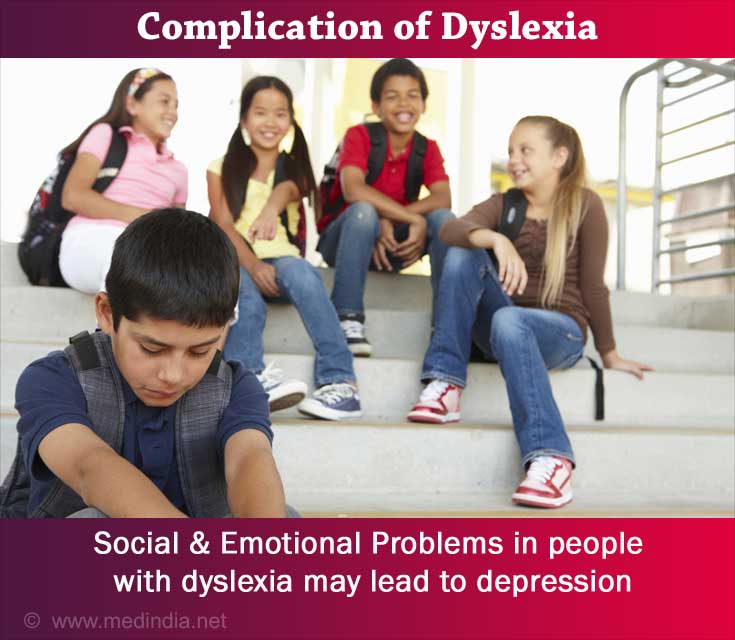
 MEDINDIA
MEDINDIA
 Email
Email
Employ dyslexia test for children, whenever you find your children finding it difficult to read with speed and accuracy.
consider this: if a (q)appears as a (p) and a (d) appears as a (b) qp db / bd pq when looked upon in a mirror. then the visual condition is neither Dyslexia nor Dysgraphia but rather the term strephosymbolia(Twisted Symbols) should be made use of . the term was coined by Dr. S.D. Orton to explain why people view text as if in a mirror & why they write in mirrored text (Backwards)from right to left , they must write in this text format in order to precieve text as if in standard format from left to right. No known medical cure to date, the gene DCDC2 linked to C6 & C15 cause strephosymbolia. paschar
This article is the problem with dyslexia. We are not ill or in need of treatment We have #D vision and can see so much more than most people. Learning to discipline that power is a rather different story, and being forced to interact with the 2D world, i.e. reading, takes special skills. But, we are great readers, often lovers of books, yet even better writers- precisely because we engage with language using all our senses. We read, but also 'see' the words, imagine the situation and from there our creativity really takes off. We read better out loud or when hearing someone read, and even envision the words on the page when we hear, while at the same time imagining the scene described and the possibilities in that space. Maps are also 2D representations that pose us problem, but once we have a visual image to anchor the 2D map, we can 'read' it better than any one AND retain the images in our memories, returning to places we've visited just once, etc. We know space, and are often in creative fields, but especially where we move through space and time, using the maxim number of our senses, which takes advantage of the 3D vision.
hi. i have two daughter's who were diagnosed with dyslexia. my older one u could see it more then the other one. my advice to some of u is to find a parent chat room for dyslexic children n they will give u advice n share different things with u. this is how i learned to cope with this.
my son, 11 years of age has dyslexia,actuallly i have noknowledge about that diseses,is it curable at d age of 11 or not plz rub me the way
i'm sorry but there is no cure but u as a parent need to learn how to help your child
dyslexia is a curable disease,u know how to help your child in his school activities,dont get tensed with his activities..take ur child for regular counselling...ur child can be cured.
Consult Pediatrician Online
Dr. Zahid Hussain
MBBS, DCH, DNB, MRCPCH
17 years experience
Peadiatric OPD, Sohna Road , Gurgaon
Dr. Janardhana Reddy
MBBS, DCH, DNB
10 years experience
Vivid Diagnostics, Hyderabad
Dr. Karthika Karthikeyan
MBBS, DNB, MRCPCH
9 years experience
Ravina hospital , Maduravoyal, Chennai
Dr. Pramod Kulkarni
MBBS, MD, MRCPCH, PGDip
38 years experience
Smile Kids Clinic, swargate signal, Pune
What's New on Medindia
Articles
Follow @MedIndia
Dyslexia - Related News
Drugs for Dyslexia